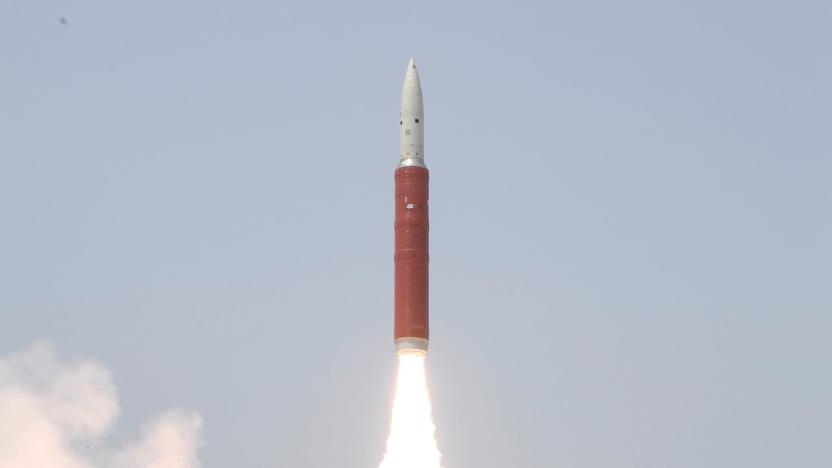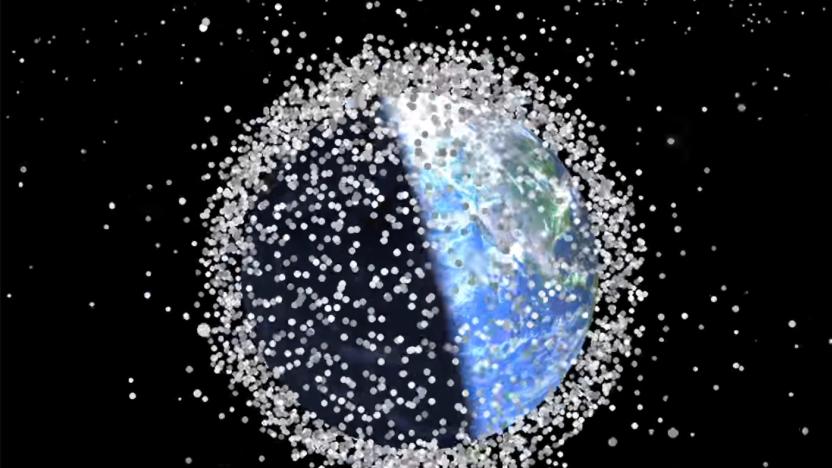Debris
Latest

NASA says satellite that India shot down may threaten the ISS
NASA chief Jim Bridenstine called India's destruction of one of its satellites a "terrible, terrible thing" that could endanger astronauts aboard the International Space Station (ISS). Addressing employees, he said a missile that shot down a satellite created at least 400 pieces of orbital debris, including 60 larger than 6 inches in size. While the satellite was well below the ISS, 24 of the pieces were blasted above its apogee, creating a potential risk. "It's unacceptable and NASA needs to be very clear about what its impact to us is," Bridenstine said.

A project to remove 88,000 tons of plastic from the Pacific has begun
An ambitious project to clean up the 88,000 tons of plastic floating in the "Great Pacific Garbage Patch" has begun. On Sunday, the Ocean Cleanup Project started towing its "Ocean Cleanup System 001" from San Francisco to a trial site some 240 nautical miles (260 miles) away. Once it arrives, the wind and waves will push System 001 into a U-shape and it will slowly drift along on its own. A 10-foot long skirt hanging below will collect pieces of plastic as small as a millimeter in size, and smaller boats will later scoop them up and take them to shore for recycling.

Japan's space junk collection experiment ends in failure
Well that's disappointing. On January 27th, Japan's space agency (JAXA) successfully launched the Kounotori 6 spacecraft to the ISS. It was supposed to test a novel method of dragging space debris out of orbit however a technical issue prevented the spacecraft from carrying out that test before its fiery death in Earth's atmosphere on Monday morning.

Watch 58 years of space debris appear in 1 minute
You probably know that the proliferation of space junk is a real problem, but we won't blame you if you have a tough time wrapping your head around the concept. There are roughly 20,000 fragments up there, after all. However, university lecturer Stuart Grey is willing to help. He recently posted a 1-minute video that shows the accumulation of junk from 1957, when Sputnik first flew, through to 2015. As the clip shows, the amount of debris grows in fits and starts. While there were several thousand objects for quite a while, missile tests and satellite collisions added thousands more fragments to the mix.

Scientists built a spacecraft that converts junk to fuel
It turns out that the sky is full of space debris, which poses a threat to craft and satellites orbiting Earth. A team of scientists at Tsinghua University in Beijing, China have come up with a way to remedy this. They've developed a spacecraft that collects the debris in a wide-cast net and uses it as fuel to propel itself forward. This technically means it could keep cleaning forever, unless an unforeseen event brings its efforts to an untimely end. Lasers have been developed for eliminating larger pieces of space junk, however aren't designed for smaller bits that are harder to locate and track. That's where Lei Lan and her team come into the picture.

This kids blanket can stop a bullet
Throughout the history of blankets, hiding behind one to escape the boogeyman has been a largely pointless tactic. Now, however, an Oklahoma company has developed a blanket that'll protect you against fictional monsters as well as the very real dangers of tornado damage and 9mm bullets. Inspired by a tragedy where 24 people died at an elementary school that didn't have a tornado shelter, Steve Walker hassled other locals to come up with a solution. A materials scientist suggested making large pads out of Dyneema, a super-thick polyethylene that's meant to be tougher than Kevlar, that kids could hide under during tornados or incidents of gun violence. The company admits that the blankets don't come cheap, since they'll cost $1,000 per child, but it's still significantly cheaper than trying to find the cash to build a shelter for every school in the state.

DARPA SpaceView program enlists us to track space debris, save a satellite today (video)
Space junk is an undeniable problem when there's over 500,000 dead satellites, spacecraft pieces and other human-made obstacles that could crash into active orbiting vehicles. DARPA is more than a little overwhelmed in trying to track all those hazards by itself, so it's recruiting amateur help through its new SpaceView program. The effort will buy time for non-professional astronomers on existing telescopes, or even supply hardware directly, to track the spaceborne debris without the sheer expense of growing an existing surveillance network. While that amounts to using hobbyists purely as volunteers, DARPA notes that the strategy could be a win-win for some when hardware donated for SpaceView could be used for regular astronomy in spare moments. The challenge is getting through the sign-up phase. While SpaceView is taking applications now, it's initially focusing on options for standard commercial telescopes and hand-picking those who have permanent access to hardware in the right locations -- there's no guarantee a backyard observatory will pass muster. Those who do clear the bar might sleep well knowing that satellites and rockets should be that much safer in the future.

UK engineers developing harpoon that could help space junk meet a fiery end
Sure, we can pull space junk out of orbit with lasers or use it to cobble together new satellites, but if engineers at space firm Astrium UK have their way, space trash could be disposed of with the help of harpoons. Currently in a conceptual stage, the system is designed to shoot defunct satellites or other debris with a harpoon mounted on a "chaser satellite" and use a tethered propulsion pack to send the rubbish in an atmospheric descent where it'll burn up. Since the projectile could shoot straight through targets and result in even more garbage, it's been fashioned with a crushable portion to reduce its speed upon impact. There's no concrete word on when the outfit's solution might be put in action, but they'll present their work on Wednesday at the 63rd International Astronautical Congress in Naples (Italy, not Florida, mind you). If you can't wait to see the harpoon at work, head past the break to catch tests of an Earth-based prototype.

EPFL's CleanSpace One: clearing up cosmic clutter (video)
Where are Lone Starr and Barf when you need'em? Would that those two (fictional) interstellar handymen-for-hire were real, space agencies like Switzerland's own, could outsource the tricky and costly intergalactic housekeeping that's fast becoming a high-priority. Instead, the famously neutral country is investing 10 million Swiss francs (about $10.8 million USD) into the production of a new breed of satellites dedicated to the collection and destruction of orbital debris. The project, dubbed CleanSpace One, will tackle one of two Swiss-borne, celestial objects -- the SwissCube or Tiasat -- for its initial mission, slated for some time within the next three to five years. While our very own NASA has proposed the use of a laser to redirect these non-operational and potentially hazardous craft, the brains over at EPFL (Swiss Federal Institute for Technology) are in the process of developing a micro-electric propulsion system, in addition to a retrieval mechanism for the unit. So, what'll happen to both this outer space Rosie and her doomed cargo? Well, rather unfortunately, it's a suicide mission, as both are destined for burn-up on re-entry. Yes, it's a rather grim end to an otherwise noble voyage, but such is the price of our scientific spring cleaning.

DARPA's new Space Surveillance Telescope will keep our satellites safe from interstellar debris
What's that in the sky? A bird? A plane? Oh, it's just some junk floating around in space, posing major threats to our military's spy satellites. To help keep an eye on it, engineers at DARPA, MIT and the Air Force have unleashed a new $110 million telescope that's been in the works for nine years now. The new Space Surveillance Telescope (SST) is capable of delivering wide-angle views of the Earth's firmament thanks to a curved CCD. This allows for a massive 3.5m aperture and f/1.0 exposure settings, capturing more light in a day that your average scope can in a week. As part of the Air Force's Space Surveillance Network (SSN), the telescope's primary task will be to look out for any microsatellites, meteors or other alien droppings moving at the same speed at which the Earth rotates. The system developed its first images earlier this year and the Air Force may eventually place SSTs all over the world, creating a 360-degree surveillance blanket and going a long way toward keeping our spycraft warm, cozy, and safe from galactic hazards.

China launches Chang'e II lunar probe, litters countryside with debris
We'll have to just put this down to a relative lack of experience. China's recent launch of the Chang'e II lunar probe seems to have gone quite alright for the rocket-propelled explorer, but it's been a somewhat bumpier experience for the people down on the ground. The booster propelling the Chang'e II into orbit found its way onto farmland near Jinsha, Guizhou Province, while the satellite's discarded casing crashed down close to Suichuan, Jianxi Province. Thankfully, it seems like neither village has suffered any casualties as a result, though the locals do now have some rather neat, atmosphere-scarred rocket shells to admire. Check out the charred hardware in the gallery below.%Gallery-104158%

'Refrigerator-sized' device to be heaved into space
If you thought hoisting a giant banana above Texas was outrageous, you may indeed chuckle to learn that a 1,400-pound refrigerator-sized container of ammonia will be jettisoned from the International Space Station next week. On July 23rd, to be precise, Expedition 15 crew member Clayton Anderson will have the, um, privilege of heading outside in order to toss "two large hunks of unneeded equipment towards Earth," and once ejected, they will be tracked by NASA for an entire year until they finally begin to enter the atmosphere. Notably, officials are still not sure where the debris will land just yet, but if you happen to find your fridge replaced with a partially disintegrated (albeit similarly sized) container of fetid material in the next year or two, you'll know exactly what went awry.[Image courtesy of MSNBC]








